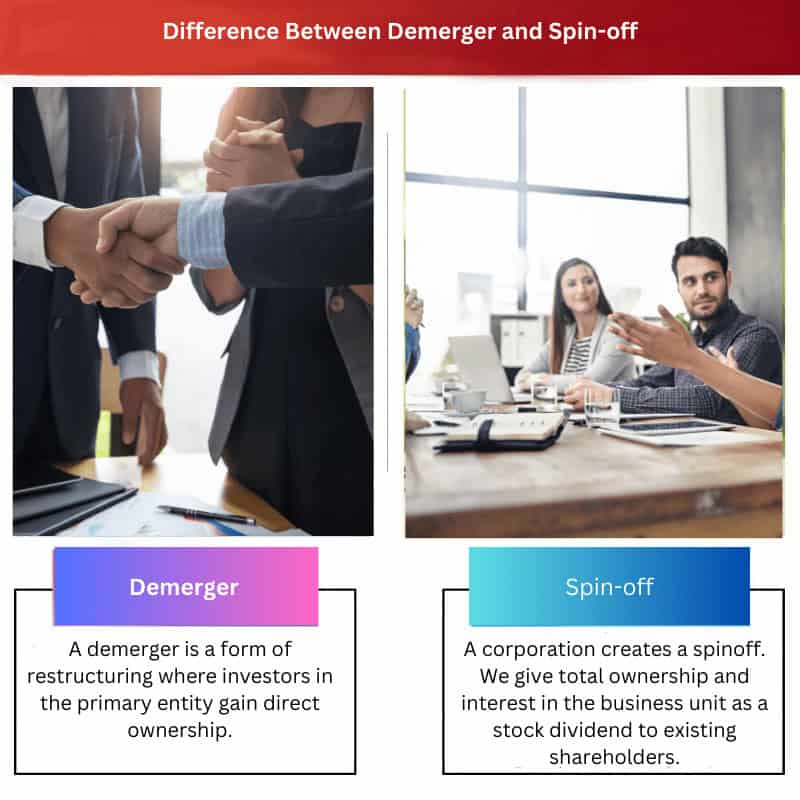A demerger involves splitting a company into separate entities, often to unlock shareholder value or streamline operations, while a spin-off entails creating a new independent company from an existing division or subsidiary, typically distributed to existing shareholders.
Key Takeaways
- Demergers involve splitting a company into separate entities, each with its management and shareholders; spin-offs create a new, independent company from a subsidiary or division.
- Demergers result in completely separate businesses; spin-offs maintain some connection to the parent company, such as shared resources or services.
- Demergers and spin-offs can unlock shareholder value, improve operational efficiency, and allow management to focus on core business activities.
Demerger vs Spin-off
A demerger is a business strategy in which a company transfers one or more of its business units into a new, separate company. A spin-off is a type of demerger where a parent company separates a business unit into a new, independent company and distributes shares of the new company to its existing shareholders.

Comparison Table
| Feature | Demerger | Spin-Off |
|---|---|---|
| Purpose | Restructure a company by dividing it into two or more independent entities. | Separate a subsidiary or business unit from the parent company to operate independently. |
| Resulting Entities | Can result in completely independent companies, or the parent company may sell or liquidate some of the demerged businesses. | The spun-off entity becomes a separate company with its own stock. |
| Tax Implications | Can be complex, with potential tax liabilities for the parent company and shareholders. Careful tax planning is crucial. | Can be tax-efficient if structured correctly, allowing shareholders to receive shares in the new company without incurring capital gains taxes. |
| Complexity | Generally a more complex process than a spin-off, requiring significant legal and financial considerations. | Less complex than a demerger, with a focus on separating a specific business unit. |
| Reasons for Restructuring | Unlock shareholder value by allowing each entity to focus on its core business and growth strategies. Improve operational efficiency. Reduce debt or raise capital. Address strategic differences between business units. | Focus on the growth potential of the spun-off entity. Attract new investors specific to the spun-off business. Simplify the parent company’s structure. |
| Examples | A media company demerges into separate entities for its broadcasting and publishing divisions. | A tech company spins off its cloud computing business. |
What is Demerger?
Reasons for Demergers
- Strategic Focus: Demergers allow companies to concentrate on core business activities by separating non-core or unrelated operations into distinct entities. This enhances strategic focus and allows each entity to pursue its specific market opportunities more effectively.
- Unlocking Shareholder Value: By demerging, companies can unlock shareholder value by enabling investors to directly invest in specific businesses. This often leads to a clearer valuation of individual businesses, potentially resulting in higher market valuations for each entity compared to the combined company.
- Operational Efficiency: Demergers can lead to improved operational efficiency by enabling each entity to tailor its strategies, operations, and capital allocation decisions to its unique business needs. This can result in cost savings, better resource allocation, and enhanced agility in responding to market changes.
- Regulatory Compliance: In some cases, demergers may be driven by regulatory requirements or constraints, such as antitrust concerns or regulatory approvals needed for specific business activities. By separating certain operations, companies can navigate regulatory hurdles more effectively.
Implementation of Demergers
- Structural Reorganization: Demergers involve a comprehensive structural reorganization of the company, including the separation of assets, liabilities, contracts, and employees into distinct entities. This process requires careful planning, legal considerations, and coordination with various stakeholders.
- Legal and Financial Considerations: Companies must address legal, tax, and financial implications associated with demergers, such as transfer pricing, tax implications for shareholders, regulatory filings, and compliance requirements. Legal and financial advisors often play a crucial role in navigating these complexities.
- Communication and Stakeholder Management: Effective communication with stakeholders, including shareholders, employees, customers, suppliers, and regulatory authorities, is essential throughout the demerger process. Clear communication helps to manage expectations, minimize disruptions, and ensure a smooth transition for all parties involved.
- Post-Demerger Integration: After the demerger is completed, companies need to focus on post-demerger integration efforts to ensure the seamless operation of each entity. This may involve establishing new governance structures, implementing transition service agreements, and addressing any remaining integration challenges.

What is Spin-off?
Reasons for Spin-offs
- Focus on Core Businesses: Companies often pursue spin-offs to sharpen their focus on core businesses. By divesting non-core or underperforming assets into separate entities, companies can streamline operations and allocate resources more efficiently to their primary areas of expertise.
- Value Creation: Spin-offs are frequently used as a means to unlock shareholder value. By separating distinct business units into independent companies, investors may gain a clearer understanding of the value proposition of each entity, potentially resulting in higher valuations for both the parent company and the spin-off.
- Market Opportunities: Spin-offs allow companies to capitalize on specific market opportunities by creating standalone entities with focused strategies tailored to particular market segments. This can enable the spin-off to pursue growth opportunities more effectively and adapt its operations to changing market dynamics.
- Capital Allocation Flexibility: Separating business units through spin-offs provides companies with greater flexibility in capital allocation. Each entity can independently access capital markets, pursue financing options, and make investment decisions aligned with its unique business objectives, without being constrained by the parent company’s overall financial strategy.
Implementation of Spin-offs
- Strategic Planning: The process of executing a spin-off begins with strategic planning, wherein the parent company evaluates its portfolio of businesses and identifies potential candidates for separation. This involves assessing factors such as the strategic fit, financial performance, and growth prospects of each business unit.
- Legal and Regulatory Compliance: Spin-offs require careful consideration of legal and regulatory requirements, including corporate governance, tax implications, securities regulations, and shareholder approvals. Companies must ensure compliance with applicable laws and regulations throughout the spin-off process to mitigate legal risks and facilitate a smooth transition.
- Financial Structuring: Companies must determine the financial structure of the spin-off, including the allocation of assets, liabilities, and capital resources between the parent company and the spin-off. This may involve conducting valuations, negotiating financial agreements, and addressing any debt or financing arrangements associated with the divested business unit.
- Communication and Stakeholder Management: Effective communication with stakeholders is crucial during a spin-off to manage expectations, address concerns, and facilitate a seamless transition. This includes communication with shareholders, employees, customers, suppliers, regulatory authorities, and other relevant parties impacted by the spin-off.
- Post-Spin-off Integration: Following the completion of the spin-off, companies must focus on post-spin-off integration efforts to ensure the successful operation of both the parent company and the spin-off. This may involve establishing new governance structures, implementing transition plans, and addressing any operational or organizational challenges arising from the separation.
Main Differences Between Demerger and Spin-off
- Corporate Restructuring Approach:
- Demerger: Involves splitting a single company into separate entities, each with its own assets, liabilities, and management structure.
- Spin-off: Entails creating a new, independent company by divesting a portion of the parent company’s business operations.
- Ownership Structure:
- Demerger: Shareholders of the parent company may retain ownership in the demerged entities, typically in proportion to their ownership in the parent company.
- Spin-off: Shareholders of the parent company often receive shares in the newly spun-off company, making them direct owners of both entities.
- Strategic Objectives:
- Demerger: Aimed at enhancing focus, streamlining operations, or unlocking shareholder value by separating distinct business units into independent entities.
- Spin-off: Driven by various strategic reasons such as unlocking shareholder value, focusing on core businesses, capital allocation flexibility, and pursuing specific market opportunities.
- Legal and Regulatory Considerations:
- Demerger: Involves legal processes for separating assets, liabilities, contracts, and employees, along with regulatory compliance and shareholder approvals.
- Spin-off: Requires compliance with legal and regulatory requirements, including corporate governance, tax implications, securities regulations, and shareholder approvals.
- Ownership Transition:
- Demerger: Ownership in the demerged entities may remain with existing shareholders of the parent company unless new shares are issued as part of the demerger process.
- Spin-off: Existing shareholders of the parent company typically receive shares in the newly spun-off company, resulting in a direct ownership transition.
- Communication and Stakeholder Management:
- Demerger: Requires clear communication with stakeholders to manage expectations, address concerns, and facilitate a smooth transition for employees, customers, suppliers, and regulatory authorities.
- Spin-off: Similarly necessitates effective communication with stakeholders to ensure understanding and support throughout the spin-off process.

The benefits and features of demergers and spin-offs are well explained here. A great resource for those involved in corporate decisions.
Absolutely, it’s an insightful article for understanding these strategies.
The insights provided in this article are certainly valuable for understanding the dynamics of demerger and spin-off in the corporate world.
The coverage of demerger and spin-off in this article is extensive and informative. A great read for anyone interested in corporate strategies.
Certainly! It’s a valuable resource for understanding these strategic business moves.
Indeed, it’s a comprehensive guide to these corporate strategies.
The article details the advantages and concepts of demerger and spin-off lucidly. A valuable read for anyone in the corporate sector.
Precisely, it offers a comprehensive understanding of these strategies.
The comparison table provided makes it easy to differentiate demerger from spin-off. It’s a great reference.
Absolutely, it’s a concise way to understand the nuances of these strategies.
The article presents the advantages of demergers and spin-offs very clearly, making it a helpful resource for business professionals.
Absolutely, the article is a comprehensive guide to these strategies.
Indeed, the value for shareholders and visibility aspects are well articulated.
The benefits of demergers and spin-offs mentioned here are very insightful and can help businesses make informed decisions.
I couldn’t have said it better myself.
I completely agree. The article provides a clear understanding of these strategies.
The detailed explanation of what demerger and spin-off entail is quite illuminating. A must-read for those in the business world.
Absolutely, the article provides valuable insights into these business strategies.
I couldn’t agree more! The clarity provided here is commendable.
This article effectively explains the differences between demerger and spin-off, and the importance of each in creating value for the company.
Absolutely, it’s crucial for investors to understand these distinctions.
The article presents a clear understanding of the demerger and spin-off concept, providing valuable information for investors and business leaders alike.
Absolutely, it’s an excellent resource for understanding these strategies.